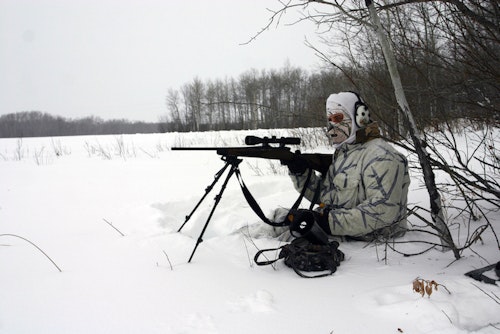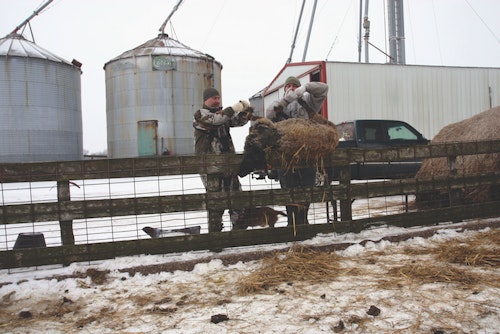The coyotes weren’t having it. My hunting buddy and I had called up several prime Alberta song dogs during the past two hours, only to watch them circle wide of our setups and disappear — most likely the result of hunting/calling pressure, and the fact that there was only a skiff of snow on the landscape and rodents were rampant. These fat and sassy canines could afford to be cautious, and were taking full advantage.
Dusk was easing toward dark as I glassed a steep slope that dropped into a brushy draw several hundred yards away, hoping for a more gullible customer on this, our final setup of the day. Since calling had been somewhat ineffective, our hunt had taken on spot-and-stalk characteristics — sneaking quietly to high vantage points and glassing for fur. Considering the amount of fresh sign we were seeing, it appeared that coyotes were plentiful in the area and it seemed reasonable that we might catch one or more on the move as they began their evening hunt. Wait! What?! I panned my bino back to the left. There on the slope I’d just glassed was a coyote, just sitting there, casually taking in the panoramic view.
I thought about getting on the coaxer to try to get the coyote back up on its feet and sweet-talk it a bit closer, but to this point such attempts had been ineffectual — counter productive, in fact. If this she-dog dropped down into the brushy cover at the base of the hill, it most likely would follow the same script as the others we’d called up. The shot was a bit farther than I like on a frontal animal but doable — 280 yards according to my rangefinder. I planted elbows to knees, leaned forward on the shooting sticks, eased the safety forward and took the slack out of the trigger. The coyote slumped forward and didn’t even twitch. The .223 Rem. hollow-point had found its mark. Finally, a beautiful blond Alberta coyote on the ground. My partner hoofed over to retrieve it while I gathered our gear for the hike back to the truck. The perfect end to an imperfect evening.
Guide and hunting buddy Kelly Wiebe and I had completed a successful spot-and-stalk combo whitetail/mule deer hunt and had a day and a half to kill before I had to catch a flight home. His inquiry, “Wanna get after some coyotes?” was like music to my ears. We’d seen several song dogs while perched up high glassing for deer and we were now applying that same tactic for coyotes — finding a good vantage point and dissecting the landscape with our Swarovski optics.
Ninety percent of the time the most effective tactic for hunting coyotes and other furred predators is to produce social or food source sounds via mouth calls or an e-caller to entice them into range. But it’s important to have the wherewithal to adapt to adverse situations — such as those times when critters do not response to conventional hunting methods. This is when hunters can become proactive by using spot-and-stalk strategies to salvage the hunt.
The following are some tactics hunters can apply when predators turn a deaf ear to their best calling efforts. A caveat: Some calling is used in many spot-and-stalk situations. It’s up to the hunter to determine when it might be effective or when it might be detrimental.

Catch Them Napping — One old-school method that some Northern red fox hunters employ is to drive around the snow-covered winter countryside looking for foxes sleeping on the downwind sides of hills, soaking in the warmth of the afternoon sun. Red foxes typically tuck tail to nose and sleep out in the open in even the most inclement weather. Once a fox is spotted, it’s a matter of getting the wind right and hiking to a vantage point where a shot might be possible, using available cover to get close enough for a setup. It might be possible to hike in and obtain a visual of the sleeping fox and make the shot. If not, set up and call softly. If the fox needs protein more than a snooze it very well might respond to the call. For this type of hunting, it’s important to have an accurate long-range rifle, because it might require a long shot at a fox that is, no doubt, sleeping with one eye open.
The Drive-by — Kelly says that when coyotes aren’t responding to the call, it’s most likely due to calling pressure or an abundance of food — as we experienced during our hunt — and hunters need to dig deeper into their bag of tricks if they hope to have any success. One option is to drive the back roads and glass for coyotes. But Kelly cautions that they are suspicious of any truck activity and for good reason. Check out nearly any ranch hand’s truck in coyote country. Notice the Easy Rider rifle rack? Need I say more? “On occasion this works,” he said. “But they’re an apex hunter and they’ve got their game on 365 days a year. They’re very suspicious, and your approach to this has to be very subtle. But if you can get it done, it’s definitely a feather in your hat.”
Once a coyote is spotted keep on driving, taking note of where it’s headed — and its attitude. If it seems overly spooked, I typically just mark the spot and move on, figuring I can come back later. If the coyote appears cool, calm and collected, I drive on and then devise a plan of attack to come in from another angle, because I’ve had very little success with a frontal attack. This means driving out of sight and then using terrain features to intercept the coyote. Sometimes this only requires hiking up the backside of a hill and laying an ambush. In this case I don’t call. I don’t want to raise the coyote’s suspicions. At this point it believes the danger is behind it, not lurking in the hills where it’s headed.
If the coyote is a no show after 10 or 15 minutes, I’ll try a little subtle calling. I figure I have nothing to lose. If I strike out again, at least I’ve got a place where I can come back and try again. Here it is important to sneak out — again using the terrain — without the coyote spotting you.
If visual contact with a coyote is made toward dusk, I might mark the spot on my GPS as a starting point for the next morning, giving it a chance to settle down. It might not be where I left it, but there’s a good chance it will be in the general area, especially during the mating season — January and February — when coyotes are seeking mates and defending territories. In this case, the spot and the stalk might be hours apart. Same goes for foxes. I recall a red fox I shot a few years back while tending my trapline in January. I spotted the cruising male while hiking back to my truck after checking some beaver sets. I watched him slip into a cattail slough and hurried home to grab my rifle. Getting the wind in my favor, I sneaked to the far side of the slough and flipped on the e-caller. Less than 5 minutes later the winter prime fox was mine.

Glass ’Em Up — Glassing is a huge part of any spot-and-stalk hunt, and that goes for predators as well as big game. And that not only means glassing from the truck, but also when on foot, including when hiking to and from setups. I believe that too many predator hunters are lackadaisical about their entries and exits to and from their calling setups. It’s important to treat each as a mini spot-and-stalk hunt. During my formative years of predator hunting, I can’t say how many times I bumped coyotes and foxes going to or returning from a calling session, and it rarely ended well.
I now take a methodical still-hunting approach and departure, glassing and hunting as I come and go. It might not happen often, but there have been occasions when I’ve surprised a critter on the way in to a stand — which should come as no surprise because I most probably picked the location because of its potential as a good place to call up a critter based on sign and/or past experience. Same goes on the way out. Too many hunters consider the game over after the setup and that can be a mistake. Chances are good they will return to hunt the same place again, and it makes good sense to avoid educating those predators that might be lurking nearby watching their departure. Coyotes will likely make the association between the calling session and the hunter’s presence. Sneak out as quietly as possible.
Also, much like with drive-by glassing, hunters on foot — those who have access to large properties — can spot-and-stalk hunt for napping or cruising coyotes and foxes. Using terrain features to avoid being sky-lined, ease up hills to establish vantage points and methodically glass for any signs of life. Give it some time, and then sneak to the next perch and repeat the process. If a fur ball of one species or the other is spotted, use the wind and terrain to get into shooting position, much like you would if you were spot-and-stalk hunting mule deer or pronghorns.
The Old Bait and Switch — And then there are naturally occurring food sources, such as a gut pile left by a successful deer hunter, dead livestock or road-killed critters. During calving season coyotes also keep close tabs of birthing cows, hoping to cash in on still-born calves or to eat the protein-rich afterbirth left behind by cows. Or you can make your own bait piles using food scraps from local restaurants, butchers or grocery stores. In many states possession of road-killed deer is just a permit from the local conservation officer away. Or during calving/lambing season if might be possible to obtain a still-born calf or lamb from a local rancher.
Where these abundant food sources exist, chances are slim coyotes and other furred predators will respond to the call — they simply have plenty to eat. No matter. A better strategy is ambush. I heard of a couple of enterprising young men who camped out at night in the comfort of a heated box blind positioned a couple hundred yards downwind from some discarded livestock. They would wait for one hour or so intervals, flip on a spot light and have at it.
Position bait stations in remote areas where furred critters feel safe visiting it during daylight hours, with setups for different wind directions. Sneak in, set up and be patient. Camp out for hours at a time if necessary. Most likely, though, those crepuscular hours just after sunrise and prior to sunset will be the most productive. Be very alert when sneaking into these bait stations because there might already be customers bellied up to the buffet. Glass them from afar before sneaking in to set up an ambush.
While using mouth calls or an e-caller to produce social and food source sounds is the bread-and-butter tactic of successful predator hunting, sometimes it’s mandatory that hunters dig deeper into their bag of tricks — especially when calling is ineffectual. Stalking predators is one way to stay in the game when the rules of engagement have changed.







